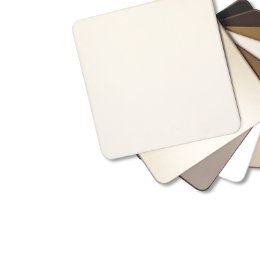Architecture Students Upstage the Stars at SXSW
| Project: | Caret 6 Architecture Installation |
|---|---|
| Location: | Austin, Texas |
| Fabricator/Installer: | University of Texas, Austin architecture students under the direction of Kory Bieg |
| Architect | University of Texas, Austin architecture students under the direction of Kory Bieg |
| Exterior Panel Manufacturer: | ALPOLIC |
| Products: | ALPOLIC®/fr aluminum composite material (ACM) in white and gray |
| Completion: | February, 2014 |
Architecture students at the University of Texas, Austin, were given an opportunity to create an innovative installation to serve as the backdrop for the winning entry in an architectural design competition. Little did they know their extraordinary design/build project would become a star in its own right, sharing the stage with celebrities performing at the world-renowned SXSW festival.

First, a Little Background
TEX-FAB, a Texas-based alliance of companies, institutions and individuals working to further the knowledge and practice of digital design and production for building components, sponsors the annual SKIN digital fabrication contest. According to the 2013 competition brief, the contest “[explores] new methods to enable the performative and aesthetic qualities of a [building] façade.”
The winning entry of 2014, titled 3xLP, is a freestanding wall based on parametrically designed geometry. Fabricated in steel, it demonstrates new possibilities for building strong, strikingly beautiful building skins.

One Inspiration Leads to Another
Kory Bieg, assistant professor of architecture at University of Texas, Austin, chairs this year’s TEX-FAB event where the winning piece will soon be on display. But when he saw it, Bieg saw a problem – and an opportunity for his students.
While impressive, the winning entry is much smaller than the gallery where it will be shown. What if a much larger installation could be created to complement the piece while filling up the space? An installation that would illustrate the design possibilities that could be achieved using the same concept? And what if his students could design and build it themselves – using the university’s own design software and CNC equipment?
A learning opportunity, a chance to push the limits of the university’s technology and a really cool piece of massive art that could help people think about and interact with architecture in a new way – that was the plan.

A New Design Based on an Old Form
Bieg created a syllabus that captured the basic goals, techniques and technologies to be used by the 17 students in his architecture studio. Each worked on their own design, creating architectural ideas incorporating the structural principles of the SKIN competition winner. The entire studio voted, then formed groups to further refine the five most successful examples.
When a clear frontrunner emerged, the group came together again to design and build the full-scale structure. The Caret 6 project emulates the vaulted spaces of Gothic cathedrals, yet reimagines them using cutting-edge materials, technologies and techniques to create a much more advanced structure and a completely new experience.
The design calls for flat materials to be cut in diamond shapes – but not uniformly. Each panel has its own specific geometry, and therefore its own unique place in the assembled structure. Unlike a Gothic cathedral, built over hundreds of years, Caret 6 is designed to be installed on location – then quickly disassembled, packed flat, moved and installed on other locations for more people to enjoy.

Advanced Technologies and Generous Donations
None of it would be possible without digital technologies. Parametric modeling tools enable structural design to evolve quickly towards an optimum solution, without compromising tolerances or requiring laborious redrawing. CNC milling flawlessly creates geometries that differ across thousands of individual components. The team even placed QR codes on each panel, so a smartphone app could be used to see exactly where they fit in the assembled structure – with no additional instructions required.
Material technology also plays a crucial role. Sheet steel couldn’t be cut by the university’s CNC equipment and was too heavy and impractical for a temporary installation. Wood wasn’t strong enough to support the design’s cantilevered structures.
Bieg had worked with ALPOLIC MCM before, when another of his student studios had created a mobile coffee pod – a beautiful reinvention of the ubiquitous and ugly urban food cart. He knew from experience that ALPOLIC materials have the strength, thinness and workability the Caret 6 project required.
As it turned out, ALPOLIC was eager to donate material to the cause of education in the service of architectural excellence. Through ALPOLIC’s Operation Encore program, MCM components are featured in community and nonprofit projects or distributed to various industry recycling streams in a commitment to green architecture.
The fastening system was specified by UT Austin engineers and purchased with funds raised through generous donations to a Kickstarter campaign. It’s worth visiting the Caret 6 Kickstarter site to meet the students, get insight into their ideas and see them at work as the project takes shape. Be sure to check out the Caret 6 project updates. There, you can see the innovative solution the students devised for getting the large ALPOLIC panels into the studio, watch the material being CNC-milled and see a full-view rendering of the final design.

Movable Inspiration
Caret 6 will be displayed at the TEX-FAB SKIN: Digital Assemblies Symposium, to be held on the UT Austin campus February 19–23, 2014. But that’s just the beginning. Organizers of SXSW – Austin’s renowned combination of film, interactive and music festivals – have selected Caret 6 as the centerpiece for the Renegade Craft Fair. After it has wowed crowds there, its creators will have about eight hours to disassemble, move and reassemble Caret 6 on the Next Stage.
There, it will serve as the backdrop for music industry events and a variety of Showcase artists from Austin’s world-famous music scene and beyond. Other destinations are in the works – unlike a Gothic cathedral, Caret 6 can easily travel to inspire people wherever it goes.
Not a bad start for a student group’s first foray into the design/build experience.






